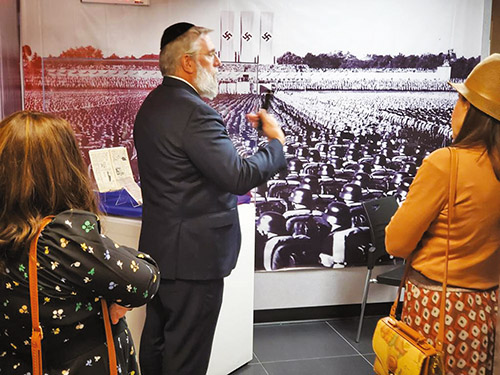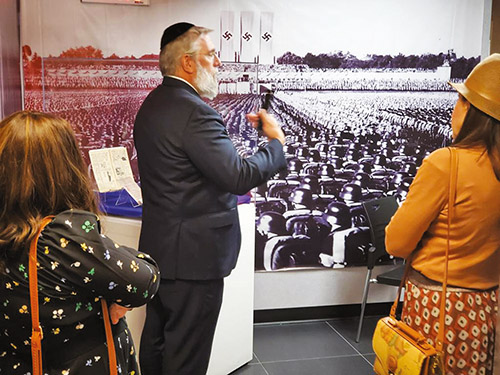
Sometimes, the best things happen serendipitously—or rather, providentially. It’s 2019 and I’m in North London, just prior to my departure home. My friend advises me about an exhibit at the Jewish Learning Exchange (JLE) in Golder’s Green, which includes artifacts and archival material about the Holocaust’s hidden children and the Kindertransport. It’s even more providential this year, as I have been the guest of a former Kindertransport refugee. I rush to the about-to-shutter exhibit and find an amazing, hands-on, kid-and-adult-friendly place. The American-born curator, Adina Abecasis, a London resident, explains that the exhibit is a part of a larger collection housed at Amud Aish Memorial Museum in Brooklyn. Rabbi Sholom Friedmann, her brother, is Director and CEO of Amud Aish. This piques my curiosity but soon whammee! COVID hits, and nobody is visiting any museums, anywhere.
Fast forward to 2023. I try to locate Mrs. Abecasis (who fortuitously is Stateside) regarding an Amud Aish Yom HaShoa presentation on April 23 at Congregation B’nai Israel in Emerson. She is unavailable that day, but Rabbi Friedmann agrees to weave documents, artifacts, and film into a montage at the synagogue. The presentation clearly resonates with the audience.
Rabbi Friedmann sometimes fields out-of-the-box questions, but this highly articulate executive coach doesn’t take long to respond. Hold on–an executive coach who heads a Holocaust museum containing 1.5 million documents? Isn’t the Holocaust all about deprivation, starvation, bullying, persecution, death, and the like? Yet Rabbi Friedmann’s dual careers are not at all contradictory, especially when you consider the Museum’s focus on the resilience and courage of the victims. It is to Jewish sources, and individual and collective victims and survivors, that Rabbi Friedmann and Amud Aish wish us to turn for insight and inspiration.

Who and what are these inspirational sources?
First, there is Amud Aish’s name. As the Torah describes it, Amud Aish is the pillar of light that guides the Jews in the desert. Rabbi Friedmann extends this as a metaphor to the Holocaust, which, he says, “is a prism into Jewish history in general and in the Diaspora.” When I ask him how this museum distinguishes itself from other Holocaust museums, he responds, “We differ with our outgoing message,” which is neither one of persecution, nor victimhood. The message is one of the resilience, as manifest in aspects of Jewish culture and positivity.
Amud Aish, Rabbi Friedmann notes, underscores the strengths not only of Jewish leadership but of the Jewish community as a whole, “the entire development of values and principles that are embedded in Jewish culture, with resilience and optimism.” He makes another critical distinction between Amud Aish and other museums. If the Holocaust narrative centers on persecution, then, he says, “that narrative ends in 1945. For us, the narrative doesn’t end until 1955,” after liberation and the DP experience.
Identifying with the Survivor Experience and Moving Forward
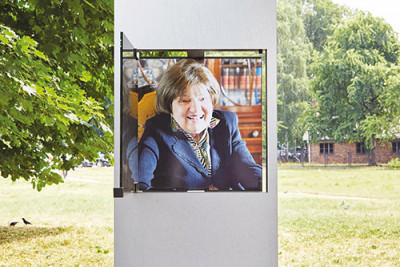
Rabbi Friedmann’s own family shares survivors’ sorrow, and resilience. His father and aunt, living in Belgium at the time of the Nazi invasion, are placed by his grandmother in a monastery and convent, respectively They survive the war, as does his grandmother, but not his grandfather. After the war, the children go to the Tiefenbruner’s orphanage in Belgium, which is supported by Agudath Israel. Mrs. Friedmann returns to Belgium to find her children. Even though she and her children are in the same city at the same time, ironically, and tragically, she never finds them there; she dies without ever seeing them again. The Friedmann children find their way to Chicago, and then to Toledo, Ohio, where Rabbi Friedmann and his siblings are raised.
Rabbi Friedmann is ordained and earns Master of Talmudic Law (MTL) and Bachelor of Hebrew Letters (BHL) degrees from the Detroit Rabbinical Academy. In the United Kingdom, he achieves Qualified Teachers Status from the Teaching Regulation Agency, a Diploma in Emotional Factors in Learning from The Tavistock and Portman NHS Foundation Trust, and a Fellowship in Holocaust Education at the Imperial War Museum, London. He also attains certification in advanced executive coaching from the College of Executive Coaching. He shares Amud Aish’s backstory.
Timeline and Birth of a Unique Educational Concept
It’s 2008. Rabbi Moshe Sherer (Agudath Israel) envisions a museum and a community resource, situated in a synagogue in Boro Park. The project, overseen by Dr. Harry Reicher, materializes, but not in a synagogue. Elly Kleinman becomes President and Founder of the Museum/AKA Kleinman Holocaust Education Center. Rabbi Friedmann is appointed Director and CEO of Amud Aish in 2012, after serving a congregation in Edgeware, London, for 15 years.
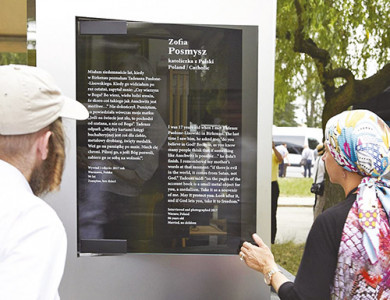
The Museum blossoms and relocates to Mill Basin, Brooklyn in 2015. Housed in 5000 square feet of the Americare building, it has a full-time staff of four, additional part-time staff, a consultant, and volunteers. It is open to everyone but primarily serves diverse school groups that range from Chasidic to Modern Orthodox to multicultural public-school students. It mainly draws from local communities. Anecdotally, its recent contest winners have been public school students.
The exhibits are appropriate for 6th grade and up, given the graphic nature of some material and the cognitive issues the exhibit raises. The displays need to make sense to the Museum’s audiences. School groups tour with a docent. To date, there are no self-guided tours. The reality is also that some people who visit the Museum have preconceived ideas about Orthodox Jews and the Orthodox community. Despite this, Rabbi Friedmann notes, “once people see the approach we are sharing, they are moved, and it is a positive experience for them.”
Where does Amud Aish have a significant impact?
In 2019, Amud Aish launches an exhibit/ installation at Auschwitz, the first museum to ever do so. Its creator is world-renowned Polish Israeli American architect Daniel Libeskind, designer of the World Trade Center Memorial and other prestigious sites
https://libeskind.com/wp-content/uploads/studio-libeskind-caryl-englander_through-the-lens-of-faith_%C2%A9huftoncrow_013.jpg. What might interest an architect of Libeskind’s stature in an installation by a relatively small museum? Libeskind, Rabbi Friedmann posits, is fascinated by the role that faith played in the Holocaust. Similarly, the priest in charge of the former Auschwitz Institute for Peace and Reconciliation (now the Auschwitz Institute for Genocide and Mass Atrocities) wants an Orthodox perspective on how Jews dealt with the Holocaust. He speaks at the installation.
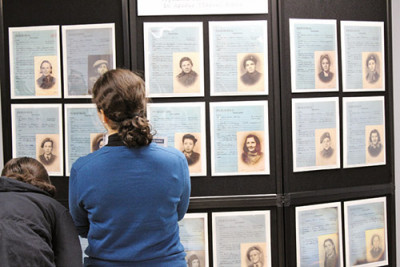
In addition to the installation at Auschwitz, Amud Aish’s other temporary exhibitions include London’s Imperial War Museum and the New York Supreme Court. The latter holds an annual Holocaust memorial commemoration. There is much about the Museum that is unique and that it shares with others.
The Museum’s messages reach as far as the Vatican. On November 11, 2015, Elly Kleinman meets with Pope Francis and other senior level Vatican officials. His gift to the Pope is a Holocaust responsa, a rabbi’s answer to an imprisoned youth who wants to exchange his place with a Torah scholar. The youth wants to die so that the scholar can live.
(https://www.timesofisrael.com/ny-orthodox-center-writes-book-for-pope-on-faith-in-the-holocaust/). Kleinman hopes that the outcomes of the meeting will increase and lead to future research in the Vatican’s Holocaust archives. In addition, Amud Aish’s partnerships with other museums make stories of resilience and survival available to larger audiences.
Joint Projects with Other Holocaust Museums
Amud Aish’s sizable collection of artifacts and documents have been donated or are on extended loan; other museums may not possess such collections. The Museum collaborates, for instance, with the United States Holocaust Memorial Museum (USHMM) on a joint archival project.
Amud Aish shares these resources, in part, because of USHMM’s dearth of Orthodox testimonies. Such resources are essential for a Holocaust museum, but beyond this, the testimonies reinforce a message critical to Amud Aish’s mission, one consistent with positivity and a legacy of faith despite a cloud of death and destruction.
An Overarching Emphasis on Positivity
“We want to get the message across that every individual has unique strengths.” For Jews, these strengths are rooted in Jewish identity, values, and culture. Throughout the millennia, in times of persecutions, Jews have tapped into these assets. As opposed to what psychologist Lawrence Langer labels “choiceless choices” –no-win solutions for those trapped by the Holocaust— Rabbi Friedmann aligns with the positivity that survivor Viktor Frankl expresses in Man’s Search for Meaning.
When a positive identity is nurtured in a child, religious or non-religious, and sustained into adulthood, that child-cum-adult is more likely to develop attitudes that lead to resilience. Amud Aish, through the way it structures its presentations and the messages it conveys, conceptualizes how individually and collectively, Jewish life can rebuild itself after the Holocaust and move forward in the Diaspora.
Rachel Kovacs is an Adjunct Associate Professor of communication at CUNY, a PR professional, theater reviewer for offoffonline.com—and a Judaics teacher. She trained in performance at Brandeis and Manchester Universities, Sharon Playhouse, and the American Academy of Dramatic Arts. She can be reached at [email protected].


